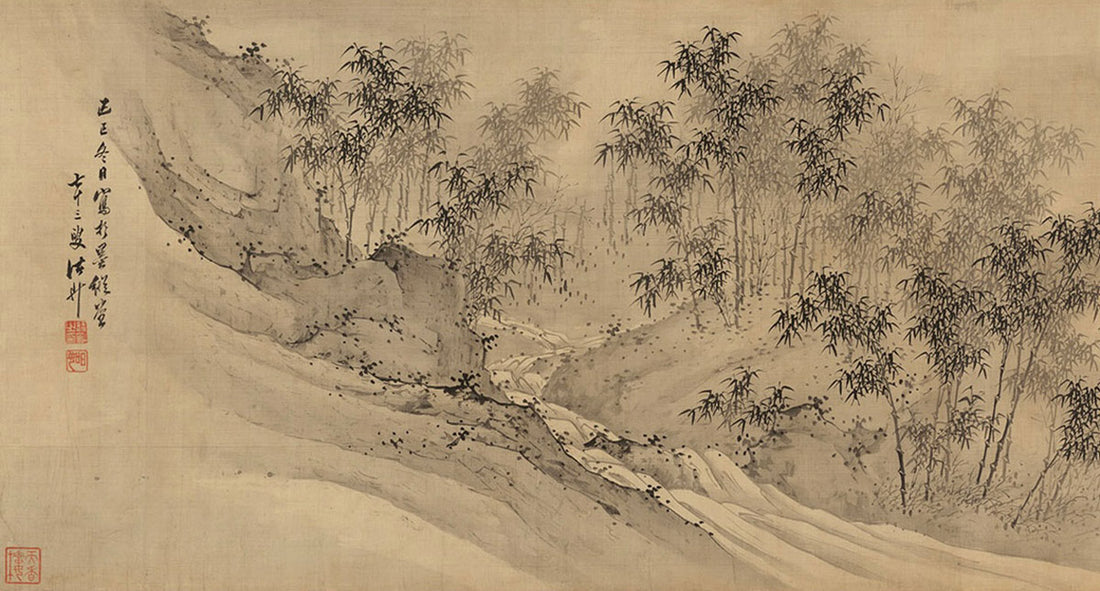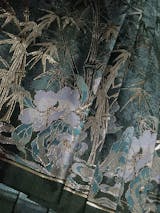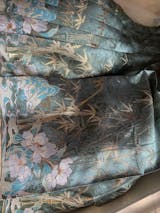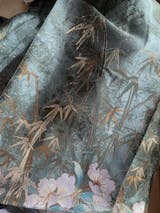
Exploring the Rich Symbolism and Stories of Bamboo in Chinese Traditional Culture
1. Symbolism of Bamboo

When it comes to traditional Chinese culture, the topic of "bamboo" is inevitable, as bamboo holds extremely rich symbolism in Chinese culture.
Firstly, bamboo symbolizes the resilient spirit and unwavering character of individuals with its tough and unyielding nature. Regardless of the environment, bamboo stands tall and strong, undeterred by wind and rain, inspiring people to persevere in adversity and march forward with courage.
Secondly, bamboo also symbolizes purity and integrity. Its pristine green appearance and independent growth - not competing with other plants for resources - make it a symbol of purity and integrity. Additionally, bamboo maintains a humble and cautious attitude throughout its growth process, embodying the qualities of humility.
Furthermore, bamboo signifies eternity and immutability. Despite its slow growth, bamboo has an incredibly long lifespan, enduring for decades or even centuries, making it a symbol of eternity and longevity.
Bamboo is not just a gift from nature but also a representation and reliance of human spirit and culture. Whether it is resilience, purity, humility, or eternity, bamboo, with its unique form and qualities, has become a symbol of people's pursuit of noble qualities and spiritual enlightenment.

2. The Verses of Bamboo: Cultural and Spiritual Inheritance
The love for bamboo among Chinese literati dates back to ancient times. As the old saying goes, "Jade may be shattered, but its whiteness cannot be altered; bamboo may be burned, but its integrity remains." With its evergreen presence, upright stature, resilience in the face of adversity, and unyielding character, bamboo exudes a unique integrity and noble spirit.
The straight and unbranched nature of bamboo signifies the honesty and openness of a nobleman, while its gradual and steady growth represents the steadfastness and diligence of a gentleman. The lush and pristine appearance of bamboo symbolizes the purity and uniqueness of a noble soul, and its ability to withstand cold without withering epitomizes the strength and incorruptibility of a moral character. These qualities of bamboo are numerous and varied. Bamboo, with its strength, elegance, and resilience, embodies the virtues of nobility, fortitude, and perseverance, inspiring individuals to stand firm and unwavering in the face of adversity without compromise. Poets, in praising the noble qualities of bamboo, also highlight their own lofty aspirations and sentiments.
Ancient Chinese literati and scholars have a special affection for bamboo, and have created a plethora of works with bamboo as the central theme. These works not only showcase the unique beauty of bamboo but also convey the lofty ideals and aspirations of the literati and scholars.

In the realm of painting, many artists excel in depicting bamboo, such as Li Kan and Wu Zhen from the Yuan Dynasty, Wen Zhengming and Xu Wei from the Ming Dynasty, Shi Tao, Gao Fenghan, and Zheng Xie from the Qing Dynasty. Their bamboo artworks vary in style, some focusing on the form of bamboo, while others emphasize its aura and temperament. These paintings not only demonstrate the artists' exquisite skills but also reveal their profound understanding and love for bamboo culture.

In poetry, bamboo serves as an important medium for literati to express emotions and ideals. They praise the noble, resilient, and elegant qualities of bamboo, associating them with human character and moral integrity, further enriching the cultural significance of bamboo.
During the Southern and Northern Dynasties, Liu Xiaoxian wrote in "Ode to Bamboo": “竹生荒野外,梢云耸百寻。无人赏高节,徒自抱贞心。” - "Bamboo grows in the wilderness, its tips reaching for the sky. Without anyone appreciating its lofty branches, it stands alone with its integrity." This verse describes bamboo growing in the wilderness yet remaining tall and reaching into the clouds, akin to individuals with talents not being recognized momentarily but still upholding their noble qualities and integrity.

In the Tang Dynasty, Du Fu wrote in "Duets with Bamboo at Yan Zheng's Residence": “绿竹半含箨,新梢才出墙。色侵书帙晚,阴过酒樽凉。雨洗娟娟净,风吹细细香。” - "Green bamboo half covered in sheaths, new shoots just emerging from the wall. Its color invades the late scrolls, its shade passes over the cool wine goblets. Rain washes it clean and fresh, and the wind brings a delicate fragrance." This depicts the thriving vitality of the bamboo forest and the fresh coolness it brings to the surroundings, expressing the poet's love for bamboo.
Additionally, Su Dongpo of the Song Dynasty wrote: “宁可食无肉,不可居无竹。无肉令人瘦,无竹令人俗。” - "Rather eat without meat than live without bamboo. Eating without meat causes thinness, living without bamboo breeds vulgarity." This succinct verse profoundly expresses the importance of bamboo in the poet's life and his reliance on and fondness for bamboo.
In the Qing Dynasty, Zheng Xie's "Bamboo and Stone" reads: “咬定青山不放松,立根原在破岩中。千磨万击还坚劲,任尔东西南北风。” - "Bite the green mountain and do not relax, standing firm amidst broken rocks. Despite being pounded and impacted repeatedly, it remains resilient against all directions of the wind." This poem praises the resilience and tenacity of bamboo in harsh environments, becoming a representative work embodying the spiritual qualities of bamboo.

In conclusion, the diverse and vibrant bamboo artworks of ancient Chinese literati and scholars not only reflect their pursuit of beauty and love for bamboo but also showcase their profound artistic and cultural accomplishments. These works are not only an essential part of Chinese traditional culture but also provide valuable insights and inspiration for people today to understand and appreciate the culture of bamboo.
3. The "Four Gentlemen" of Bamboo
Plum blossom, orchid, bamboo, and chrysanthemum. These four plants were revered by ancient Chinese scholars as the "Four Gentlemen". Each of these plants, with their independent and unworldly characteristics, represents the qualities of pride, elegance, solidity, and purity. Among them, the plum blossom blooms in the cold winter, symbolizing a spirit of resilience and steadfastness; the orchid blossoms in tranquil valleys, embodying the graceful beauty in Chinese culture, associated with nobility and transcendence; bamboo symbolizes integrity, strength, and perseverance; while the chrysanthemum blooming in the mountains and fields signifies the hermit life away from worldly affairs.

In traditional Chinese paintings, the "Four Gentlemen" are often depicted as subject matter, not only to praise and appreciate these four plants, but also to celebrate and uphold the traditional virtues and spirits of the Chinese nation.
4. The Historical Origins of Bamboo
According to archaeologists, the origins of bamboo can be traced back to approximately 70 million years ago on Earth, when the climate was warm and humid, conducive to the proliferation of plants. With the passage of time, bamboo gradually evolved into its modern form.

In China, the earliest records of bamboo can be dated back to the Neolithic period about five to six thousand years ago. In the relics of the Yangshao culture approximately 6000 years ago, archaeologists identified the character "竹" (bamboo) on unearthed pottery. This indicates that in the ancient past, people had already begun to recognize and utilize bamboo. Additionally, bamboo has been excavated at the primitive society site of Hemudu in Yuyao County, Zhejiang Province, indicating that ancient people had started planting bamboo over 7000 years ago.
Bamboo has a wide range of uses, not only in the production of furniture, paper, musical instruments, food packaging, and building materials but also plays a significant role in Chinese culture and arts. From ancient times to the present, bamboo has had a profound influence in Chinese literature, painting, architecture, and other fields, becoming an essential component of Chinese culture.
5. The Tale of the Seven Sages of the Bamboo Grove
In the vast river of culture, bamboo stands as a treasure of Chinese civilization with its unique posture and profound connotation. Among them, the legendary story of the "Seven Sages of the Bamboo Grove" is particularly captivating. These seven sages befriended bamboo, played music, recited poems, and painted, expressing their yearning for freedom, independence, and transcendence from the mundane world.
Each sage had a different personality, but they all harbored lofty ideals, shunned the allure of power and privilege, and revered nature and authenticity, embodying the steadfastness and composure of bamboo. They often gathered beneath the bamboo groves around Yuntai Mountain, drinking, singing, composing poems, and discussing worldly affairs. Their laughter, songs, and conversations echoed through the bamboo groves, as if the bamboo itself were imbued with their spirits, standing taller and greener.

Each of them possessed unique personalities and talents. Some excelled in debates, others in music, calligraphy, painting, or drinking. Together, they were like a vibrant symphony, each playing their own melody. With their extraordinary talents and distinct characters, they won the admiration and respect of the people of their time.
The story of the "Seven Sages of the Bamboo Grove" is not just a legend about bamboo culture and spirit but also a valuable spiritual treasure. They help us deeply understand the cultural implications and spiritual demeanor of bamboo, offering us valuable life insights: in the fast-paced modern life, we should be resilient and composed like bamboo, facing life's challenges with unwavering beliefs and perseverance.
Today, the lush green bamboo grove still stands tall, as if narrating the story of the seven sages.
6. Bamboo and Martial Arts
There is a profound cultural connection between bamboo and martial arts. In the world of martial arts, bamboo is not only a common natural landscape but also carries rich cultural connotations and symbolic meanings.
Firstly, the form and characteristics of bamboo resonate with the spirit of martial arts in many ways. Bamboo grows straight and tall, undaunted by wind and rain, resilient and unyielding, traits that mirror the noble character and unwavering will of martial arts characters. In martial arts novels, many heroes are symbolized by bamboo, showcasing their indomitable spirit and steadfast commitment to justice.
Furthermore, bamboo is often used as an important prop or setting in martial arts stories. For example, in martial arts films, bamboo forests are often significant locations for battle or seclusion. The serene and mysterious atmosphere of bamboo groves adds depth to martial arts stories, making bamboo an indispensable element in martial arts culture.

Moreover, bamboo in martial arts culture carries a unique aesthetic value. The lush green of bamboo complements the verdant mountains and rivers of the martial arts world, creating beautiful scenes. The portrayal of bamboo in literary and cinematic works also showcases its unique artistic charm, making bamboo a picturesque element in martial arts culture.
Bamboo not only provides rich material and settings for martial arts stories but also, through its distinctive form and characteristics, becomes an essential part of martial arts culture. In future martial arts creations, it is believed that bamboo will continue to exert its unique charm, adding more color and depth to the world of martial arts.
7. The Wisdom of Bamboo in Zen Culture
Zen, as an important sect of Chinese Buddhism, emphasizes the direct discovery of one's true nature to attain enlightenment. Bamboo, as a living organism in nature, with its growth process, form, and characteristics, deeply align with the wisdom of Zen. Bamboo grows rapidly but does not rush to maturity; instead, it progresses step by step, accumulating strength gradually. This parallels the Zen concept of sudden enlightenment, emphasizing the gradual understanding of the truth in daily life, rather than achieving it instantly. Additionally, the hollow nature of bamboo symbolizes the state of "no-self" pursued in Zen, transcending the ego and merging with the greater whole.

As a natural entity, bamboo's growth process, form, and characteristics embody Zen's unique understanding of nature and life. Zen emphasizes respect and compliance with nature, and the organic growth of bamboo without excessive human intervention resonates with the concept of "doing without doing" in Zen, reflecting the natural and authentic pursuit of Zen practitioners. The upright posture, hollowness, and nodes of bamboo not only reflect the perseverance and humility that Zen practitioners should embody but also imply the state of emptiness, selflessness, and non-attachment sought after by practitioners.

In Zen cultural context, bamboo is often used as a symbol and metaphor to express the wisdom and practice concepts of Zen. For instance, the hollow nature of bamboo symbolizes humility and inclusivity, representing a state pursued by Zen practitioners. The resilience of bamboo signifies the perseverance and resolute spirit required in the practice. Furthermore, the growth process of bamboo embodies Zen's understanding of life and time - emphasizing the transience of life, the importance of cherishing the present, and striving for self-improvement. Bamboo frequently appears in Zen poetry, paintings, and other artistic works, further deepening the intrinsic connection between bamboo and Zen culture through artistic expression.
 Lastly, from a spiritual perspective, both bamboo and Zen culture emphasize inner calmness and transcendence. Zen practitioners often contemplate nature and life truths through meditative practices such as sitting quietly observing bamboo or listening to the sound of bamboo in the wind, aiming to achieve inner peace and transcendence. The characteristics of bamboo, such as its resilience and emptiness with nodes, inspire individuals on how to maintain inner strength and emptiness to face life's challenges and difficulties.
Lastly, from a spiritual perspective, both bamboo and Zen culture emphasize inner calmness and transcendence. Zen practitioners often contemplate nature and life truths through meditative practices such as sitting quietly observing bamboo or listening to the sound of bamboo in the wind, aiming to achieve inner peace and transcendence. The characteristics of bamboo, such as its resilience and emptiness with nodes, inspire individuals on how to maintain inner strength and emptiness to face life's challenges and difficulties.The deep significance of the relationship between bamboo and Zen culture lies in their natural harmony, cultural resonance, and spiritual pursuit. This connection enriches the depth of Zen culture while providing a new perspective and approach for people to understand and experience Zen wisdom. Through the natural symbol of bamboo, individuals can more intuitively appreciate the charm and wisdom of Zen culture, further practicing the spiritual pursuit of Zen in daily life.
8. The Utilitarian Value and Environmental Benefits of Bamboo
Bamboo, this green treasure in the natural world, not only carries profound cultural connotations but also, with its unique utilitarian value and environmentally friendly characteristics, has become a prominent natural resource in modern society.
In terms of practical value, bamboo has a wide range of applications, permeating various aspects of our lives. In the construction field, bamboo is often used as a building material for simple houses due to its toughness and lightweight characteristics. Especially in earthquake-prone areas, bamboo structures are highly favored for their excellent seismic performance.

Additionally, bamboo can be crafted into various household items such as baskets, curtains, beds, chairs, and tables, all of which are not only aesthetically pleasing but also emanate a strong natural aura. Moreover, bamboo can be utilized for flooring, adding a unique beauty to indoor spaces with its natural texture and sturdy performance.

In daily life, from tableware to furniture, from stationery to handicrafts, bamboo products, with their simple, natural, and eco-friendly attributes, have gained increasing favor among consumers.
As a fast-growing, renewable plant, bamboo plays a positive role in slowing global warming and preserving the ecological environment. In its growth process, bamboo absorbs large amounts of carbon dioxide, helping to mitigate the greenhouse effect. Additionally, bamboo cultivation requires minimal fertilizers and pesticides, reducing damage to land resources and maintaining soil health. Furthermore, bamboo waste can naturally degrade without polluting the environment.

Lastly, bamboo also holds edible value. Bamboo shoots are not only a common ingredient widely used in Asian cuisine, but they also offer rich nutritional value, including vitamins and plant sterols, providing multiple health benefits to the human body.
Closing Thoughts
Bamboo, as a shining gem in traditional Chinese culture, its profound symbolism and Zen wisdom, moisten our hearts like flowing water. It is not only a touch of green in the natural world, but also a brilliant star in human culture and spirit.
Walking through the bamboo forest is like being in an elegant and transcendent painting. The swaying bamboo shadows, each bamboo plant like a modest gentleman, quietly expressing the resilience and perseverance of life. Through the baptism of wind and rain, they stand tall like warriors in life, fearless and fearless; under the sunlight, they appear so relaxed and content, like spirits between heaven and earth, emitting a fresh breath.
Bamboo is also a mirror of the soul. It allows us to see our inner world, guiding us to transcend ourselves and pursue the greater self. In the world of bamboo, we can feel the tranquility and peace, and also understand the transcendence and freedom.
In the days to come, may we all live like bamboo, resilient and graceful in this world. Faced with the challenges and difficulties of life, let us embrace the spirit of bamboo, maintain a calm and firm heart, uphold humility and restraint, and continuously pursue progress and growth; Let us, with the company of bamboo, continuously seek truth and wisdom, allowing our souls to be purified and elevated in the bamboo forest.
🎋🎍🌿>>Explore our collection of bamboo-inspired items here!










